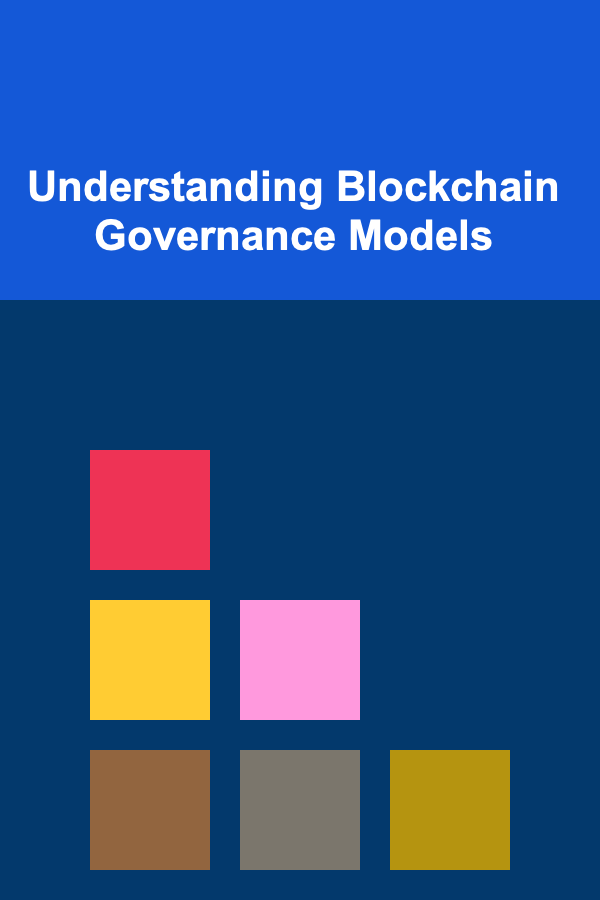
Understanding Blockchain Governance Models
ebook include PDF & Audio bundle (Micro Guide)
$12.99$8.99
Limited Time Offer! Order within the next:

Blockchain technology, beyond its function as a distributed ledger, is fundamentally about creating decentralized and trustless systems. However, even in a decentralized environment, decision-making processes are crucial for the long-term viability and adaptability of the network. This is where blockchain governance comes into play. Understanding the different governance models is essential for anyone involved in developing, using, or investing in blockchain technology. This article provides an in-depth exploration of blockchain governance models, their complexities, trade-offs, and real-world examples.
What is Blockchain Governance?
Blockchain governance refers to the set of rules, processes, and stakeholders involved in making decisions about the development, maintenance, and evolution of a blockchain network. It encompasses how changes are proposed, debated, voted upon, and implemented. Unlike traditional centralized systems where a single entity (e.g., a company or government) controls decision-making, blockchain governance aims to distribute power among participants in the network.
Governance is critical because blockchains are not static entities. They require ongoing development to address bugs, improve performance, adapt to changing user needs, and incorporate new technologies. Poor governance can lead to stagnation, disputes, forks (splits in the blockchain), and ultimately, the failure of the project. Effective governance, on the other hand, fosters a healthy ecosystem, encourages innovation, and ensures the long-term sustainability of the network.
Key Aspects of Blockchain Governance
Several key aspects define a blockchain governance model:
- Decision-Making Process: How are proposals for changes to the blockchain created, discussed, and evaluated? What mechanisms are in place for reaching consensus and making decisions?
- Stakeholder Involvement: Who gets to participate in the governance process? This could include developers, miners/validators, token holders, users, and other members of the community. How is their influence weighted?
- Voting Mechanisms: What methods are used to cast votes on proposals? Common methods include on-chain voting (using tokens or stake), off-chain signaling, and delegated voting.
- Transparency and Accountability: How transparent is the governance process? Are proposals, discussions, and voting records publicly available? Are participants held accountable for their actions?
- Implementation and Enforcement: How are decisions implemented and enforced? This may involve code changes, software upgrades, and other actions.
Types of Blockchain Governance Models
Blockchain governance models can be broadly categorized into several types, each with its own strengths and weaknesses:
1. On-Chain Governance
On-chain governance refers to governance mechanisms that are directly embedded within the blockchain protocol itself. This means that proposals, voting, and sometimes even the execution of changes occur directly on the blockchain, using smart contracts and cryptographic techniques.
Characteristics:
- Direct Voting: Token holders or validators can directly vote on proposals using their tokens or stake.
- Automated Execution: If a proposal receives sufficient support, the changes are automatically implemented by the blockchain protocol.
- Transparency: All proposals, votes, and execution records are publicly visible on the blockchain.
- Potential for Efficiency: On-chain governance can be more efficient than off-chain governance, as it automates many of the decision-making processes.
Examples:
- Tezos: Uses on-chain governance to allow token holders to propose, vote on, and implement protocol upgrades. The process involves several stages, including proposal submission, voting, and testing.
- Decred: Employs a hybrid approach that combines on-chain voting with Proof-of-Stake (PoS) and Proof-of-Work (PoW) consensus mechanisms. Token holders can vote on proposals using their stake, and the results are used to determine which changes are implemented.
Advantages:
- Increased Transparency: All governance activities are recorded on the blockchain, making them publicly auditable.
- Greater Efficiency: Automated execution of changes can speed up the decision-making process.
- Reduced Centralization: On-chain governance can distribute power more evenly among token holders.
Disadvantages:
- Potential for Governance Attacks: Malicious actors could potentially acquire a large number of tokens or stake and use them to manipulate the governance process.
- Complexity: Implementing on-chain governance can be technically complex.
- Low Voter Turnout: Token holders may not always participate in voting, leading to decisions being made by a small minority. This can create a false sense of legitimacy.
- Inflexibility: Once a governance system is implemented on-chain, it can be difficult to change.
2. Off-Chain Governance
Off-chain governance refers to governance processes that occur outside of the blockchain itself. This typically involves discussions, debates, and voting that take place in forums, online communities, or other communication channels. Decisions made off-chain are then implemented through code changes and software upgrades, which are typically coordinated by core developers.
Characteristics:
- Informal Discussions: Discussions and debates about proposals take place in various online forums and communities.
- Social Consensus: Decisions are typically made based on social consensus among developers, miners/validators, and other stakeholders.
- Manual Implementation: Changes are implemented manually by core developers, based on the decisions made off-chain.
- Flexibility: Off-chain governance is generally more flexible than on-chain governance, as it allows for more nuanced discussions and adjustments.
Examples:
- Bitcoin: Relies heavily on off-chain governance, with developers, miners, and community members participating in discussions and debates about protocol upgrades. Changes are typically implemented through Bitcoin Improvement Proposals (BIPs), which are discussed and reviewed by the community.
- Ethereum (Before PoS): Used off-chain governance extensively. Ethereum Improvement Proposals (EIPs) were the primary mechanism for suggesting and discussing changes to the protocol. The core developers held significant influence in determining which EIPs were implemented.
Advantages:
- Flexibility and Adaptability: Off-chain governance allows for more flexible discussions and adjustments to proposals.
- Expert Input: Developers and other experts can provide valuable input into the decision-making process.
- Reduced Risk of Governance Attacks: It's more difficult to manipulate off-chain governance processes compared to on-chain governance.
Disadvantages:
- Lack of Transparency: Off-chain discussions can be opaque, making it difficult for ordinary users to understand the decision-making process.
- Centralization of Power: Core developers often hold significant influence in off-chain governance, leading to concerns about centralization.
- Slow Decision-Making: Reaching consensus off-chain can be a slow and cumbersome process.
- Potential for Disputes: Disagreements among stakeholders can lead to forks and fragmentation of the community.
- Vulnerability to Social Engineering: The focus on social consensus makes off-chain governance more susceptible to manipulation through social engineering tactics.
3. Delegated Proof-of-Stake (DPoS) Governance
Delegated Proof-of-Stake (DPoS) is a consensus mechanism that also influences governance. In DPoS systems, token holders vote for a set of delegates (also known as witnesses or block producers) who are responsible for validating transactions and securing the network. These delegates also play a key role in governance by proposing and voting on changes to the blockchain protocol.
Characteristics:
- Elected Delegates: Token holders elect a limited number of delegates to represent them in the governance process.
- Delegate Voting: Delegates vote on proposals for changes to the blockchain protocol.
- Efficiency: DPoS systems are generally more efficient than other governance models, as decisions are made by a smaller group of delegates.
- Accountability: Delegates are accountable to the token holders who elected them and can be voted out if they don't perform well.
Examples:
- EOS: Uses a DPoS consensus mechanism, where token holders elect 21 block producers to validate transactions and govern the network.
- Lisk: Also employs DPoS, with token holders voting for 101 delegates who are responsible for securing the blockchain and participating in governance.
Advantages:
- High Efficiency: DPoS systems can achieve high transaction throughput and fast confirmation times due to the limited number of delegates.
- Scalability: DPoS is often seen as a more scalable governance model compared to other approaches.
- Accountability of Delegates: Delegates are accountable to the token holders who elected them and can be voted out if they don't perform well.
Disadvantages:
- Potential for Centralization: DPoS systems can be prone to centralization, as a small number of delegates may control a large portion of the network.
- Voter Apathy: Token holders may not actively participate in voting, leading to delegates being elected with low voter turnout.
- Collusion Among Delegates: Delegates could potentially collude to manipulate the governance process or extract value from the network.
4. Liquid Democracy
Liquid democracy (also known as delegative democracy) is a governance model that combines elements of direct democracy and representative democracy. In liquid democracy, individuals can either vote directly on proposals or delegate their voting power to a trusted representative. This allows for a more flexible and dynamic form of governance.
Characteristics:
- Direct Voting or Delegation: Individuals can choose to vote directly on proposals or delegate their voting power to a trusted representative.
- Fluid Delegation: Individuals can change their delegation at any time, allowing them to switch representatives based on their expertise or alignment with their views.
- Scalability: Liquid democracy can scale to large groups, as individuals can delegate their voting power to representatives who have expertise in specific areas.
Examples:
- Snapshot: A popular off-chain voting platform that uses a form of liquid democracy. Token holders can vote directly on proposals or delegate their voting power to others.
- Futarchy: A theoretical governance model that combines liquid democracy with prediction markets. Voters delegate their votes to policies, and prediction markets are used to determine which policies are most likely to achieve desired outcomes.
Advantages:
- Increased Participation: Liquid democracy can encourage more participation in governance, as individuals can choose to vote directly or delegate their voting power.
- Expertise-Based Voting: Individuals can delegate their voting power to representatives who have expertise in specific areas.
- Flexibility and Adaptability: Liquid democracy is a flexible and adaptable governance model that can be tailored to the needs of different communities.
Disadvantages:
- Complexity: Liquid democracy can be more complex than other governance models, making it difficult for some individuals to understand.
- Potential for Delegation Chains: Delegation chains can become complex and difficult to track, potentially leading to unintended consequences.
- Risk of Sybil Attacks: Malicious actors could create multiple identities to gain influence in the governance process.
5. Hybrid Governance Models
Many blockchain projects are now adopting hybrid governance models that combine elements of different approaches. This allows them to leverage the strengths of each model while mitigating their weaknesses. For example, a project might use on-chain voting for certain types of decisions and off-chain governance for others.
Examples:
- Polkadot: Employs a complex on-chain governance system that involves a council, a technical committee, and token holders. The council proposes and votes on proposals, while the technical committee focuses on technical issues. Token holders can also participate in governance by voting on referenda.
- Dash: Utilizes a dual governance system. Miners secure the network through Proof-of-Work. Masternodes, which require a significant DASH collateral, vote on treasury proposals that fund the development and marketing of the Dash ecosystem.
Advantages:
- Tailored Solutions: Hybrid governance models can be tailored to the specific needs of a particular blockchain project.
- Balanced Decision-Making: Combining different governance models can lead to more balanced and informed decision-making.
- Increased Resilience: Hybrid models can be more resilient to attacks and manipulation than single-model approaches.
Disadvantages:
- Complexity: Hybrid governance models can be complex to design and implement.
- Coordination Challenges: Coordinating different governance mechanisms can be challenging.
- Potential for Conflicts: Conflicts may arise between different governance mechanisms or stakeholders.
Challenges and Considerations in Blockchain Governance
Designing and implementing effective blockchain governance is a complex and challenging task. Several factors need to be considered:
- Stakeholder Alignment: Ensuring that the interests of all stakeholders (developers, miners/validators, token holders, users) are aligned is crucial for the success of a blockchain project.
- Incentive Structures: Designing appropriate incentive structures is essential to encourage participation in governance and prevent malicious behavior. Tokenomics plays a significant role here.
- Scalability: Governance mechanisms need to be able to scale to accommodate a growing number of participants and proposals.
- Security: Governance systems need to be secure against attacks and manipulation. This includes both technical security (e.g., preventing double-spending) and social security (e.g., preventing vote buying).
- Decentralization vs. Efficiency: There is often a trade-off between decentralization and efficiency in blockchain governance. More decentralized systems may be slower and less efficient, while more centralized systems may be faster but less resistant to censorship.
- Evolving Needs: Blockchain networks operate in a rapidly evolving environment. Governance models must be flexible and adaptable enough to meet the changing needs of the community and the technology.
- Voter Apathy: Overcoming voter apathy is a significant challenge. Strategies to encourage participation, such as simpler voting interfaces, educational resources, and even incentives, are crucial.
- Information Asymmetry: Some stakeholders may have more information than others, leading to an uneven playing field in governance. Transparency and educational initiatives can help address this issue.
Real-World Examples and Lessons Learned
Examining real-world examples of blockchain governance can provide valuable insights into the successes and failures of different approaches:
- The DAO Hack (Ethereum): The DAO (Decentralized Autonomous Organization) was a smart contract-based investment fund that was hacked in 2016. The incident highlighted the importance of security audits and formal verification in smart contract development. The Ethereum community ultimately decided to hard fork the blockchain to recover the stolen funds, a controversial decision that demonstrated the power of social consensus and the potential for conflicts in governance.
- Bitcoin Block Size Debate: The Bitcoin block size debate was a long-running dispute over the optimal size of blocks in the Bitcoin blockchain. The debate ultimately led to the creation of Bitcoin Cash, a fork of Bitcoin with a larger block size. This demonstrates the potential for disagreements over fundamental parameters to lead to forks and community fragmentation.
- Tezos On-Chain Governance Upgrades: Tezos has successfully implemented several protocol upgrades through its on-chain governance system. This demonstrates the potential for on-chain governance to facilitate efficient and transparent decision-making.
- EOS Governance Challenges: EOS has faced several governance challenges, including concerns about centralization and collusion among block producers. This highlights the potential for DPoS systems to be prone to manipulation.
The Future of Blockchain Governance
Blockchain governance is still a relatively nascent field, and there is ongoing experimentation and innovation. Some key trends and developments include:
- Increased Sophistication of Governance Mechanisms: As blockchain technology matures, we can expect to see more sophisticated governance mechanisms that address the challenges of scalability, security, and stakeholder alignment.
- Integration of Decentralized Autonomous Organizations (DAOs): DAOs are increasingly being used to manage blockchain projects and communities. DAOs provide a framework for decentralized decision-making and resource allocation.
- Focus on User Experience: Making governance more accessible and user-friendly is crucial for encouraging participation. This includes developing intuitive voting interfaces and providing clear and concise information about proposals.
- Development of Governance Tools and Standards: The development of standardized governance tools and frameworks can help to improve the efficiency and interoperability of blockchain governance systems.
- Experimentation with New Governance Models: Researchers and developers are constantly experimenting with new governance models, such as futarchy, quadratic voting, and conviction voting.
- Greater Regulatory Scrutiny: As blockchain technology becomes more mainstream, we can expect to see greater regulatory scrutiny of blockchain governance. Regulators may seek to ensure that blockchain governance systems are transparent, accountable, and compliant with existing laws and regulations.
Conclusion
Blockchain governance is a critical aspect of ensuring the long-term sustainability and adaptability of blockchain networks. Understanding the different governance models, their strengths and weaknesses, and the challenges involved is essential for anyone involved in this space. As blockchain technology continues to evolve, we can expect to see further innovation and refinement of governance mechanisms. The best governance model for a particular project will depend on its specific needs and goals, and there is no one-size-fits-all solution.
By carefully considering the various options and learning from the experiences of existing projects, it is possible to design and implement effective blockchain governance systems that promote decentralization, transparency, and long-term value creation.

How to Create a Minimalist Budget for a Simpler Financial Life
Read More
How to Sanitize Your Home's High-Touch Surfaces Regularly
Read More
How to Save Money on Laundry Services
Read More
How to Scale Your Business by Selling Your Own Designed Products on Amazon
Read More
Profiting from Deep Learning: How to Start Earning Passive Income
Read More
How To Master Composition Rules
Read MoreOther Products

How to Create a Minimalist Budget for a Simpler Financial Life
Read More
How to Sanitize Your Home's High-Touch Surfaces Regularly
Read More
How to Save Money on Laundry Services
Read More
How to Scale Your Business by Selling Your Own Designed Products on Amazon
Read More
Profiting from Deep Learning: How to Start Earning Passive Income
Read More